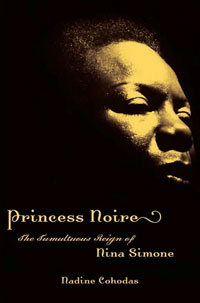The High Priestess of Soul

There are artists—musicians and actors—who once they take the stage, their power up there is so compelling that for those moments when they are before you, nothing else matters. Probably the list of such gods is different for everyone (mine includes Thelonious Monk, Astor Piazolla, Abbey Lincoln). But for those who have seen Nina Simone (born Eunice Waymon in Tryon, N.C., in 1933), I would offer that she occupies a very special place.
(Of course, today we have Lady Gaga, who actually may have enough talent to warrant attention without the gimmickery.)
Now comes a full-bodied biography, Princess Noire: The Tumultuous Reign of Nina Simone (Pantheon),by Nadine Cohodas, who has also written of another legendary chanteuse, Dinah Washington.
At the height of her career, Simone was reputed to be a difficult and moody performer (the word “diva” comes to mind). Cohodas’s comprehensive profile charts Simone’s traumatic disappointment at her rejection by the Curtis Institute of Music (thus effectively ending her aspirations for a career as a classical pianist) and a long list of travails that add up to a stormy life story. Ultimately, a disaffected and alienated Nina Simone left the United States and end up in France, where she died in 2003. Unknown until after her death, Simone was diagnosed early on with bipolar disorder, multiple-personality disorder, and later with schizophrenia.
Luckily for you (us), YouTube gives easy access to the magic and power of Simone with an array of her performances: “Here Comes the Sun,”“Feelings,”“Ain’t Got No Home,”“Four Women,”“Mississippi Goddam,”“Go Limp,” and of course, the riveting Screamin’ Jay Hawkins anthem “I Put A Spell On You “ (also the name of her autobiography).
